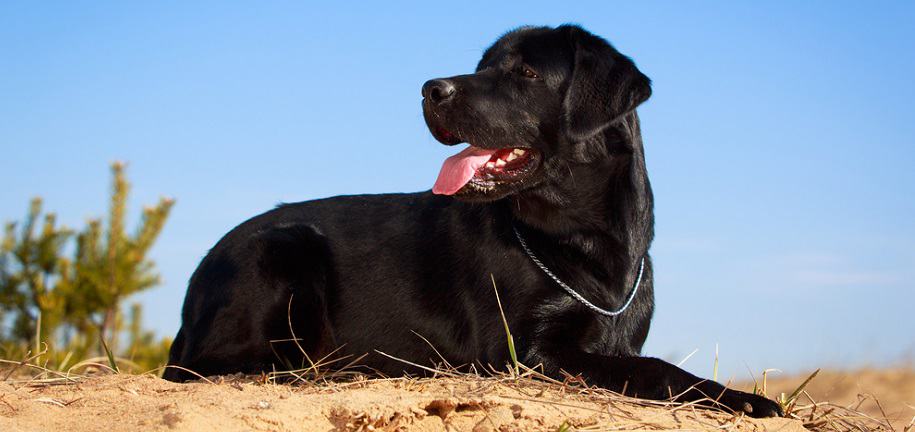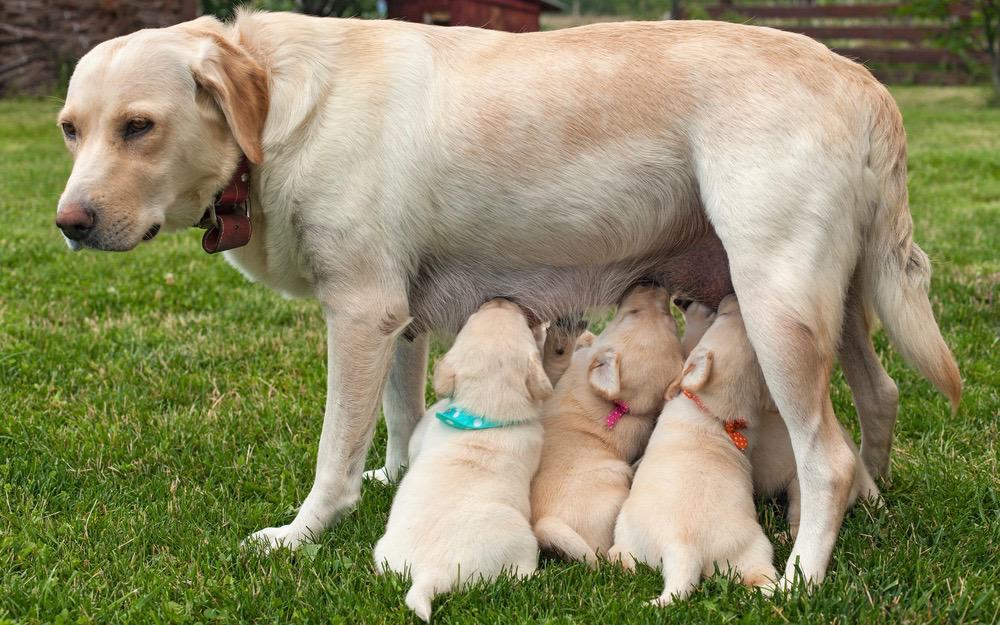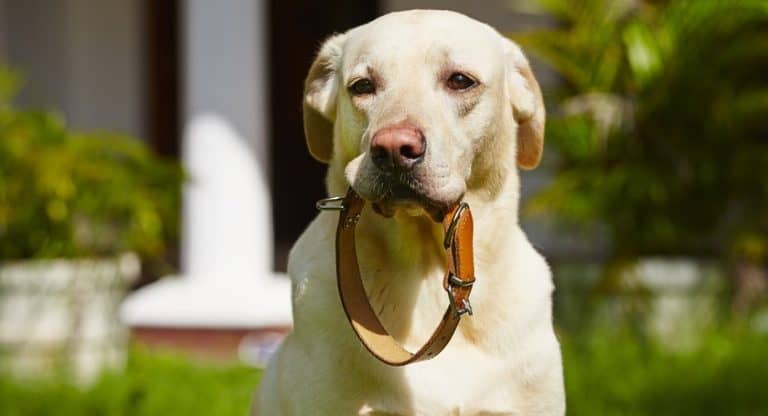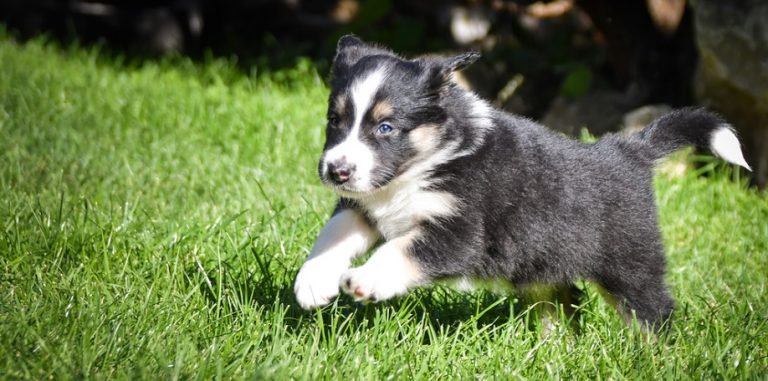Labrador Growth Chart – Lab Weight Chart & Size Chart
Labradors are the most popular dog to own in North America. Known for their happy disposition and excellent rapport with children, it is easy to understand why they are always in demand.
But, even though they are popular, you need to make sure that your puppy is growing at the right rate.
You can do this by following a Labrador growth chart or a lab puppy weight chart.
These charts will allow you to monitor your puppy’s weight to help determine whether he is growing too much too quickly or if he is not gaining enough weight fast enough.
When Do Labs Stop Growing?

There is no perfect age that will mark when your puppy will stop growing. As far as height and body size go, your puppy should be done growing by his first birthday, but this is not always the case.
It has been shown that labs will continue to gain weight between their first and second birthday, even if they are not getting any taller.
That is why it is important to monitor their weight to make sure they are not becoming overweight.
Much of this depends on the dog himself, however, so just make sure your dog is staying on his growth curve.
Lab Weight Chart
Looking at a Labrador growth chart can help give you an idea of what you should be able to expect as your puppy grows.
Even though every lab is different and birth weights are not a good indicator of final size, you still should be able to get an idea of how big your dog will be when he is two months old.
Taking a look at the Labrador puppy growth chart, you will want to follow your dog’s age to the average weight for that age. Males are going to be bigger than females in general.
Using that basis, you should be able to make a guess at how big your dog will be as he continues to grow.
Using the labrador weight chart will give you an idea, but you also need to visually monitor your puppy.
You should not be able to see your dog’s ribs but should be able to feel them if you run your hand down their ribcage.
Labrador Weight Chart By Age
| Age | Male Average Weight | Female Average Weight |
|---|---|---|
| 3 Months | 22-26 lbs | 20-26 lbs |
| 5 Months | 35-49 lbs | 33-49 lbs |
| 7 Months | 51-59 lbs | 40-55 lbs |
| 9 months | 57-68 lbs | 48-62 lbs |
| 11 months | 62-75 lbs | 53-66 lbs |
| 13 months | 64-77 lbs | 55-68 lbs |
| 24 months | 65-85 lbs | 55-75 lbs |
Likewise, after the first couple of months, you should be able to easily see your puppy’s waist when you look down at him.
If your dog seems too thin or too big, you should adjust food accordingly and speak to your vet. The labrador weight chart is only a guide.
Labrador Growth Chart – What To Expect

Birth – 2 Weeks
When your Labrador puppy is a newborn, you can expect him to weigh between 8 and 24 ounces.
He will grow quickly, however, and it is important to remember that birth weight is not a good indicator of final size.
Their eyes will not be open right away and they will not move away from their mom in their first couple of weeks, relying solely on her milk for nutrition and sustenance.
3 Weeks – 12 Weeks
You will really notice some serious growth between 3 and 12 weeks. Your puppy will now be moving all around and most likely getting into mischief.
By 12 weeks, your puppy is likely to weigh between 10 and 20 pounds, depending on the sex of your dog and his genetic predisposition.
Your puppy should be eating three times a day at this point and will have weaned off of his mother’s milk by 8 weeks.

4 Months – 6 Months
Between the ages of 4 and 6 months, your puppy will really have a growth spurt. You should see an increase in his appetite and his overall energy level.
You can expect a puppy of this age to weigh between 25 and 40 pounds, depending on the size of your dog.
This will be the period of the last major growth spurt before their growth will slow down. You should still be providing 3 meals a day if possible.
7 Months – 9 Months
Your Labrador puppy will still be on the growth chart between 7 and 9 months. He will have slowed down his growth speed but still, be getting taller and gaining weight.
Your lab is likely to weigh between 40 to 50 pounds at this point, but it might be a little more depending on your dog. You can reduce his meals to twice a day now, but make sure he is getting enough to eat.

10 Months – 12 Month
Your puppy will still be growing between 10 and 12 months, but he is likely to be at or close to his final height.
He is likely to weigh somewhere between 50 and 60 pounds at this point, but you will need to really watch your puppy’s weight to make sure that he is not overeating.
Labs really like their food and will overeat if given the opportunity to.
Adult
Your Labrador puppy should have reached his full height by 12 months of age, but you can expect to see him continue to gain weight until age 2.
Labs have larger chests in general, but you want to look for a waist with your dog.
It is good to be able to feel your dog’s ribs, but you should not be able to see them. If you are concerned about your lab’s adult weight, make sure to discuss it with your vet.

How Big Do Labs Get?
There are some general indicators that you can use to guess how big do Labs get. Puppies with large paws, for example, are set to be large dogs. But that doesn’t give you an exact idea.
Using a Lab growth chart can help you get an idea of how big your puppy will be once he is done growing.
You cannot use this for a reference with a newborn puppy, because birth weight is not going to tell you how big your dog will be by the end of his growth cycle.
Following the Lab puppy weight chart, you should be able to find where your puppy was weight and height-wise when he was 8 weeks old.
As long as he stays on the same growth curve, you can estimate how big he will be.
How To Weigh Your Labrador Puppy?
Getting a wiggly puppy to sit on a scale can be a trick. Weighing your puppy regularly can ensure that your puppy is growing at the right pace.
One way to do this is to take your puppy to the vet for a weight check routinely, but this is not always practical.
The most realistic way to weigh your puppy regularly is to first weigh yourself on the bathroom scale and write it down. Then, pick up your puppy and hold him while you get back on the scale.
Then subtract your weight from the weight with you holding the puppy and you will have his weight.
Do Labs Still Grow After Being Neutered?
A common question is whether your lab will stop growing after being neutered?
Your dog is not going to stop growing immediately after being neutered or spayed, but generally, dogs that were neutered or spayed during puppyhood are slightly shorter than dogs that were neutered later on.

Current science says that if you can wait to neuter or spay your dog until he is at least one, your dog will have fully developed bones and there will not be any negative result to his size or cause him to have conditions like hip dysplasia.
Reasons Why Your Lab Puppy Might Not Be Growing
There are a few reasons that your puppy might not be growing. Some labs are genetically smaller than other labs and there is a chance that you just have a petit lab.
If your puppy had smaller parents, chances are good that he will be small as well. Likewise, working labs are less likely to be heavy and your puppy might not be on the lab puppy weight chart at all.
That said, if your puppy seems to not be growing, there might be a couple other things going on. Your puppy might not like his food and be eating only what is necessary.
This is less likely with labs since they are typically very happy to eat and like food, but it might happen if you are trying to make your puppy food yourself or are opting for something a little unusual.
Puppies need a lot of calories and homemade foods often cannot give everything that they need. You should also make sure that you are offering him enough food three times a day.
If your puppy is not getting bigger or refusing food, it is best to consult with your vet and make sure there is not anything wrong.
Labrador Size Chart
In general, Labradors are not very long as far as dogs go. They are a little on the stocky-side and have long tails, but not as long as other large breeds.
Looking at their height, the average height of an adult male Labrador is between 22.5 and 24.5 inches. The average height for a female Labrador is between 21.5 and 23.5 inches.

While they are considered a large breed dog, Labradors can have shorter legs and be a little bit stockier.
The height averages are a little bit tricky to determine for sure, because there is a lot of variety within the breed.
Some colors or types of Labradors are shorter than others, so you might not have a good idea for how tall your lab will be without knowing his parents.
The growth chart can guide you to help you know what to expect.
How Big Is A Labrador Puppy When He Is Born?
As a newborn, a Labrador puppy weighs between 8 to 24 ounces. At this stage, your puppy is only feeding on the mother’s milk as their source of nutrition.
The milk contains all the required nutrients that the puppy needs to grow at this stage of development.
When they are born, the eyes and ears of a Labrador puppy are closed, and they cannot hear or see.
This means that they depend on the mother for everything including cleaning, elimination, and regulating their temperatures.
How Big Should A 6-Month-Old Labrador Be?

A Labrador puppy that is 6 months old is already a strong and big dog. Their average size is between 20 and 22 inches at their shoulder with a weight of about 53 and 57 pounds.
Your Labrador will grow in height at this stage, and after one year they will grow breadthways.
At 6 months, your Labrador is a very curious and active dog that keeps on discovering the outside world.
They need careful and special attention from you including moderate training, a balanced diet, and regular visits to the vet for examinations to ensure that they remain healthy.
What Is The Size Of A Full-Grown Labrador?
A Labrador is considered fully grown when they have reached their physical, mental, and sexual maturity.
A Labrador puppy reaches their adult height at the age of 12 months, but they will continue adding weight until the age of about 2 years.
As an adult, a female Labrador weighs between 55 and 75 pounds while a male Labrador weighs between 65 and 85 pounds.
Both male and female Labradors stand at a height of between 22 and 24 inches as adults.
Is Labrador A Medium Or Large Dog Breed?
Are you wondering whether your Labrador is a large or medium breed? Well, a Labrador is a medium- to large-sized breed.
They are solid and sturdy dogs with an almost square appearance, sturdy legs, and a strong body.
Males Labradors have a maximum height of 24 inches which places them in the medium-sized breed category, but they are also a large breed because of their sturdy build and some of them can weigh above 60 pounds which is a characteristic of large breed dogs.
Will My Puppy Experience Growing Pains?
Large breeds are more susceptible to suffering from growing pains until they are around the ages of 18 months.
The growing pains often dissolve themselves in some dogs but for others, the pain can last longer causing too much pain and discomfort.
If you notice that your Labrador shows signs of limping, lameness, lethargy, weakness, reluctance to walk, and loss of appetite, take them to the vet for a check-up to rule out any other medical conditions.
If the vet diagnoses them with growing pain, he/she will administer treatment according to the type of disorder that is causing the pains.
Some vets may suggest that you give supplements such as glucosamine, chondroitin, omega-3 DHA, and antioxidant plant extracts to help relieve the pain.
Speak to your vet before giving your Labrador any type of supplements.
Labrador Body Shape Changes
The typical shape of a lab includes a strong, large chest. This accommodates the powerful lungs that are typical of labs. Their chest comes out from the spine and curves toward the belly.
They will also have a slimmer waist. As your puppy grows, this shape will become more evident. A narrow chest is not typical with the breed and they have a tendency to lose their waist if they become overweight.
Your lab should also have powerful hindquarters that help make the dog speedy for retrieving.
They are hunting dogs, after all, and their shape should reflect their genetic predisposition for retrieving prey. Your adult lab’s legs should look straight when viewed from behind.
American vs English Labrador Size
Labradors might be one of the most popular dog breeds in the world, but you might not have realized that there is a difference between American and English Labradors.
In general, the American breed standard of a Labrador is larger than the English Labrador. On average, the American Lab should be between 21 and 25 inches in height. Meanwhile, the average height for an English Lab is between 21 and 23 inches.
Interestingly enough, both the UK Kennel Club and the American Kennel Club recognize them as one breed. There is only Labrador Retrievers breed they are not divided between American or English Labs.
Even though there is a clear difference between the two, the kennel clubs do not recognize them as separate.
English Labs are usually heavier-built than their American counterparts, with larger chests, and generally appear more solid. They also have wider heads and thicker necks.
Labrador Body Condition Score (BCS)

While we determine human weight health through the use of the Body Mass Index (BMI), we determine a dog’s weight health through the Body Condition Score (BCS). This helps you gauge your dog’s health.
The BCS works on a scale from 1 to 9, with the ideal weight being right in the middle, with a score of 5. This is not based on a specific weight, since there are so many dog breeds out there, but instead is based on the look and feel of a dog.
The ideal BCS means that you cannot see your dog’s ribs, but you can feel them easily under his fur. You also should be able to see his waist when looking from above, with no fat deposits poking out.
Dogs under 5 will need to increase their weight, whereas dogs that are over 5 on the scale should lose some weight.
How To Help Your Lab Lose Weight If He Is Overweight
Unfortunately, Labradors have a tendency toward becoming overweight. They really like to eat and will not stop, even if they should be full. So, do not feel bad if your lab has become overweight.
The first thing that you need to do is confirm with your vet that your lab is simply overweight and there is nothing else going on.
Your vet will likely have some tips to help reduce your dog’s weight, but there are some other things that you can do too.
- Look at the treats that you are feeding him. Are you feeding your dog too many treats? Are you feeding your dog the right treats? Not all treats are created equal and going with treats that are lower in calories is best.
- What kind of food are you feeding him? The second thought is whether you are feeding your dog the right kind of food in the right quantity. Go with a high-protein, low-grain food that is rich in nutrients.
- Increase his walk time. Just like humans, Labs need exercise to stay fit. Increase his outside and exercise time as much as you can.
What Is A Labrador’s Neck Size?
Looking at the average neck size for a lab, you will find that is between 18 and 24 inches in diameter, placing them securely in the large breed category of dog.
While the neck size will depend greatly between dogs, it is not a big indicator of health or anything else. It is important to know your dog’s neck size to buy the right kind of collar.
To measure your lab’s neck, you will need to use a tape measure around the area where he will wear a collar. Do not let the fur deceive you. If the collar is floating on the fur, it will fall right off.
When Does A Lab Puppy Become An Adult Dog
Puppyhood often seems like it ends too soon. For labs, you can expect your puppy to become an adult dog by 12 months of age. Their growth will slow down after 6 months and they should settle into their adult height by their first birthday.
Your dog might still fill out up to age 2, gaining a little bit more weight and broadening in the chest.
Some people consider a dog that has reached sexual maturity as an adult dog. For a lab, that can happen any time after 6 months, usually sometime between 6 months and 12 months, but that can vary dog to dog.
Personality-wise, your lab puppy should calm down and lose that puppy wild energy by age 2.
Factors That Affect Labrador Puppy Growth
Genetics
Genetics is the number one factor that will determine how big your Labrador will get. Dogs with smaller parents will be smaller. There are also several types of Labradors out there.
Not only are there black, chocolate, and yellow, but there are working labs and English labs. Every type of lab has a tendency toward a certain size and shape that will not be affected by how much or what he eats.
Nutrition
Puppies need a lot of calories and healthy food to grow well. Your puppy needs to have proper nutrition. When he is a newborn puppy, this should just mean milk from his mother.
As he grows, however, make sure that you are feeding your puppy healthy food in the right quantities three times a day. Poor nutrition can result in poor growth and the development of health issues in the future.
Physical Activity & Health
It is incredibly important to keep your lab as fit and healthy as possible. In general, an adult lab should get at least 2 hours of exercise every day. This will help keep his weight and his body healthy.
Puppies need much less exercise, so do not overwork your puppy. If your dog is suffering from arthritis or dysplasia, make sure to follow your vet’s guidance on exercise before starting an exercise plan.
How Long Are Labradors Pregnant?
Labradors are pregnant the same average time as other breeds of dogs, which is about 63 days from conception. As with any mammal, the length can vary from pregnancy to pregnancy.

It can be hard to determine the precise conception day, even if you know when the dogs mated, because seminal-fluid can be active for up to 48 hours after the act. A veterinarian can do testing to determine a more precise date. This is usually hormone measurements.
Breeders will monitor hormones with smears and blood tests to know when to breed their dogs so should have a good idea.
How Many Puppies Do Labradors Have?
The amount of puppies that a lab will have varies from pregnancy to pregnancy. Typically, labs will have 6 to 8 puppies at a time, but they can also have only 1 puppy or even as many as 12.
It is not uncommon to see 10 puppies at a time. A dog can have a small litter one time and a larger litter the next time.
It varies a lot. It is more common to have several puppies than to have only 1 or 2, but anything can happen. Your veterinarian can perform an ultrasound to see how many puppies there are.
What If My Labrador Is Not The Right Weight
If your Labrador puppy seems to be underweight or overweight, there are a few things that you can look at. If your puppy is low on the labrador weight chart, it is best to get a visual check on your dog to see if it is just his body type or if he is thin.
If you see your dog’s ribs, your lab is too thin. Make sure that he is eating enough, but if he does not seem to gain weight, check with your vet to make sure there isn’t anything wrong.
If your dog is heavier than the growth chart says he should be, you might want to cut back your dog’s food and ensure he is getting enough exercise.
It doesn’t take much reduction to make a difference, and it is always important to ask your vet before you try anything.
What Is The Life Expectancy Of Labrador?
Like all large breed dogs, Labrador retrievers are likely to leave you too soon. On average, a lab will live between 10 and 12 years, but this number varies. If your dog has other health issues you might need to say goodbye sooner.
Since labs have a tendency to be overweight, it is best to keep your dog active and on healthy food to keep his weight down and stave off other health complications that might shorten your dog’s life expectancy.
Some genetic defects might also shorten his life, but you do not have control over that.

How Much Does It Cost To Own A Labrador?
The first big cost of a Labrador is the initial purchase. If you are adopting from a shelter or a private owner who is not a breeder, you might be looking at a couple of hundred dollars in adoption fees.
If you are adopting from a breeder directly for a pure bred lab, you can easily spend thousands to buy the dog.
Annually, your lab will cost over $1000 in food alone, but if your dog has any health issues, you can be looking at thousands more in veterinary care.
Labrador Genetics And Common Health Problems
All dog breeds have a tendency toward certain genetic conditions or health issues. In a lab, common genetic issues include distichiasis, which is a kind of exhaustion caused by exercise, diabetes, muscular dystrophy, hip dysplasia, and shoulder dysplasia. Joint dysplasia is more common than the other conditions.
Labradors also have a healthy appetite which means that they are going to be prone to being overweight, resulting in or worsening other health conditions.
Their joints will stay healthier being lighter and they will be less likely to develop diabetes.
It might cost more to keep your dog on healthier food, but you will save money in medical expenses by doing so.
They can also develop other minor health issues like retinal dysplasia or retinal atrophy, resulting in blindness, as well as hypothyroidism, hot spots, and arthritis. Your vet can monitor the likelihood of these conditions at your dog’s annual check-up.
Frequently Asked Questions
How Much Exercise Does A Labrador Need?
Because they are a more energetic breed than most dogs, Labradors need a good amount of frequent exercise to stay healthy and use up their energy.
For Labrador puppies, a good starting point is the ‘Five-Minute Rule’, which says that puppies should have five minutes of daily exercise for each month of their age.
For instance, a six-month-old Labrador puppy would need half an hour of exercise per day, while a two-month-old lab should have no more than 10 minutes every day.
This rule of thumb can be followed until the lab reaches adulthood.
Adult Labradors are fully developed and need more exercise as a result. An adult lab should get at least 80 minutes of exercise every day, depending on their energy levels.
Good forms of exercise for Labradors include walks, games of fetch, and running around open spaces – high-quality exercise is important, so make sure your lab gets some off-lead time!
At What Age Do Labradors Start To Calm Down?
Labradors are known for being hyperactive dogs, especially when they are younger. While labs do settle down and stop bouncing off the walls as they mature, you’ll still have to deal with an excitable dog for a little while as they’re growing up.
Typically, a Labrador will begin to settle down at any point between their first birthday and hitting 18 months old.
A Labrador raised with the correct handling techniques will start to be calmer on the sooner side of things, but no two labs are the same and even a properly raised Labrador can still be excitable until they are around 16-18 months old.
They are still practically a puppy at this point, however, and most Labradors will only really develop a calmer temperament when they are around 2-3 years of age.
Do Different Labradors Grow At Different Speeds?
Labradors come in three main varieties: chocolate labs, black labs, and yellow labs.
They’re also often distinguished between American Labradors and English Labradors.
While the main differences between the first group are the color of their fur, American labs and English labs are quite different in terms of their sizes and builds.
American labs are larger and leaner than their English cousins, who are typically shorter and stockier by comparison.
The difference in size doesn’t drastically change how long it takes for American labs and English labs to grow, although their appearances differ as they mature.
They both take between 12-14 months to finish growing in height, and take up to 2 years to fill out completely.
However, the American Labrador tends to take longer to grow vertically, with less time for filling out their more athletic frame; the English Labrador, meanwhile, reaches its full height slightly before to account for more time filling their body out.
Color doesn’t really play into growth at all, with little to no difference between the growth time for chocolate, yellow, and black Labradors.






